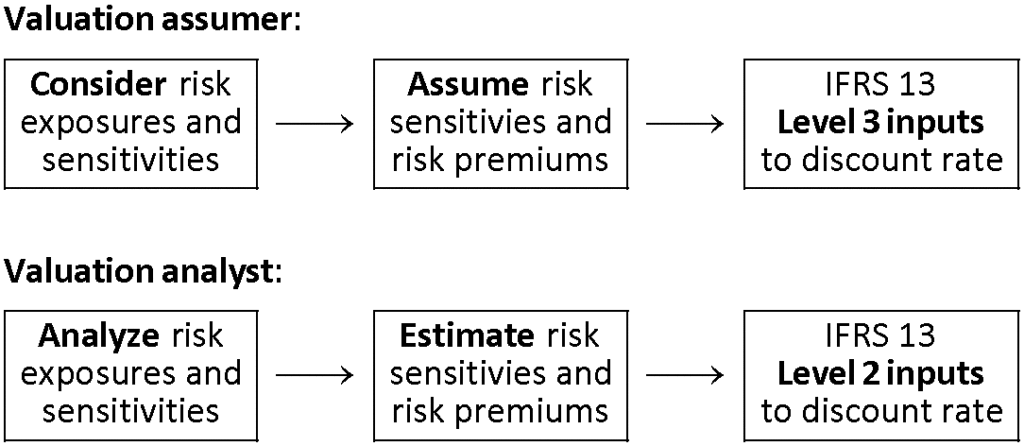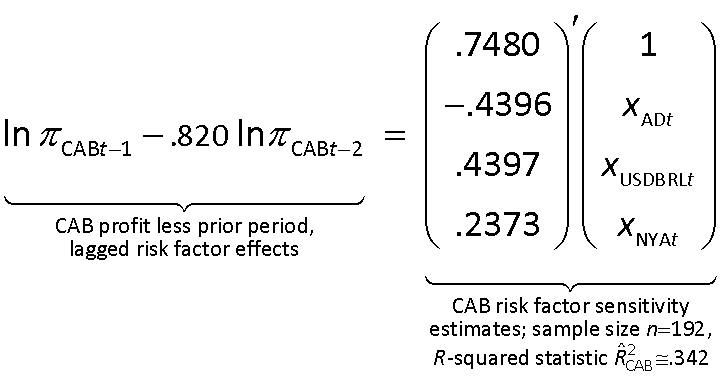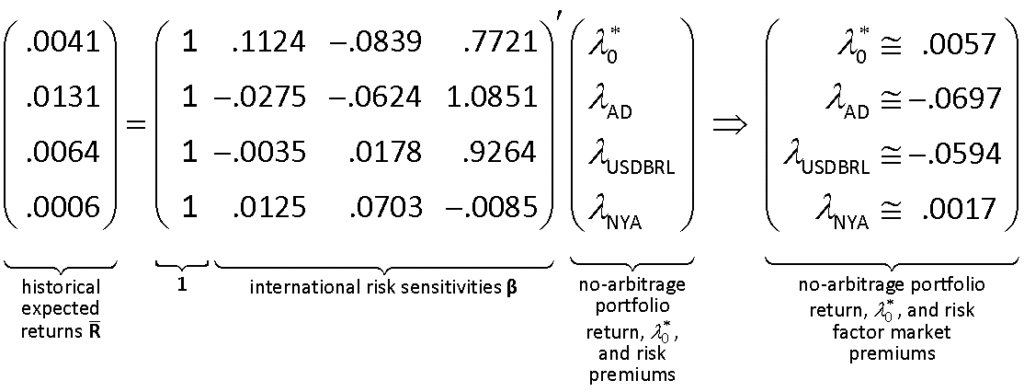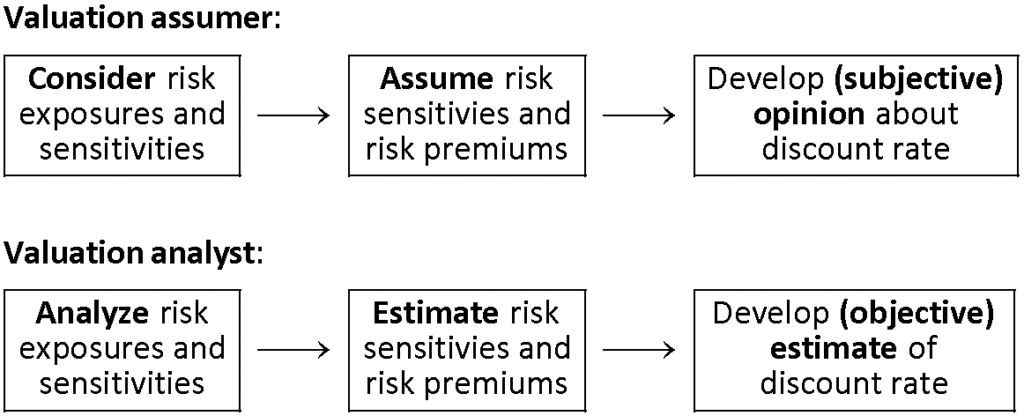Avast! Are we not valuation analysts? No. We are valuation assumers.

Those in the sub-discipline of the finance profession employed in estimating values of privately-held and -traded capital assets refer to themselves by a fascinating array of–sometimes dyseuphonic–titles including business appraisers, valuers, valuators, valuation advisors, valuation consultants, valuation specialists, and valuation analysts. A potential title not yet used–for obvious reasons–would be “valuation assumers”; though, as will be seen, it would seem appropriate in many cases. :- )
Let’s focus on the title valuation analyst because it is (1) used by NACVA (National Association of Certified Valuators and Analysts), which is one of the largest professional associations related to capital asset valuation in the world in recent years, and (2) analysis is the most descriptive explanation of what valuation professionals are actually supposed to do. Consider the following definition:
anal·y·sis \ ə-ˈna-lə-səs \ 1a: a detailed examination of anything complex in order to understand its nature or to determine its essential features // a thorough study doing a careful analysis of the problem; 1b: a statement of such an examination. 2: separation of a whole into its component parts. 3a: the identification or separation of ingredients of a substance // a chemical analysis of the soil; 3b: a statement of the constituents of a mixture.
https://www.merriam-webster.com/dictionary/analysis
.
I’ve asserted that valuation professionals often might be more accurately called valuation assumers, but according to the most descriptive title they call themselves valuation analysts. So, which is it: Are valuation professionals more like analysts or more like assumers? And why does this matter?
A caveat before we begin: I want to say that I personally find NACVA to be a serious professional association that does its best to certify and develop competent valuation professionals; and to my knowledge provides the only valuation profession credential accredited by the National Commission for Certifying Agencies in the US. So, this article is not a criticism of NACVA; it is an observation about the valuation profession taken as a whole. With this caveat, let’s begin …
1. What does it mean to analyze value?
Business valuation professionals value capital assets. This article is about what professionals call “business valuation” and what academics call “asset pricing.” There are important reasons why the terminology matters–which I will avoid for the sake of brevity–but to be clear this article is about estimating the value of capital assets; assets that provide pay-offs in terms of cash flows rather than assets that provide service flows (e.g., human capital, natural resources, etc.).
Capital asset values depend on expected future cash flows, which is to say that the “market approach” to valuation is often irrelevant or inappropriate for many capital assets. But many professionals in corporate finance, equity analysis, and valuation believe that the value of equity interests can be estimated using equity pricing multiples of “comparable companies.” It can be shown that using equity pricing multiple results in high variance and, therefore, unreliable value estimates … and we know why: No company is exactly comparable to the equity interest being valued, particularly in terms of the risk exposures and the sensitivity of cash flows to such risks (cf. McLelland).
So using equity pricing multiples to estimate equity value will provide, at best, a (usually broad) range of valuation estimates. Why would anyone engage a valuation professional for estimating a broad range of values, when they could do the same thing themselves in about 30 minutes? (They wouldn’t and they don’t, which is why in some respects the valuation profession is presently in a minor state of crisis.) Moreover, not all capital assets are equity interests. We need general methods for estimating value and the most general method, upon which all modern asset pricing theory is based, is what is informally known as the discounted cash flow (DCF) method: The value of any capital asset, including derivatives, can be estimated using the DCF method; not just equity interests.
Capital markets price risks. We know from asset pricing theory and empirical evidence that buyers and sellers in the capital market price, hedge, and diversify risks; this is not a hypothesis. The capital market does not price assets or even cash flows per se; the market prices risks and such pricing is accomplished through the aggregate buying, selling, hedging, and diversification activities of traders; their aggregate activities all influence, and result in, the market prices of risks (cf. McLelland).
For those who believe capital markets price either capital assets or cash flow streams directly, consider the following question: How do you determine the opportunity cost of investing in a particular asset or cash flow stream? The answer is that there is only one, optimal way to do this according to all modern asset pricing theories (CAPM, APT, certainty-equivalent (risk-neutral) pricing theory): determine the sensitivity of the asset’s cash flows stream to various risk factors; estimate the way the capital market prices those risk factors; and, then, derive a risk-adjusted expected market rate of return for the particular set of risk sensitivities of the asset and the market prices of the risk factors (cf. McLelland). This opportunity cost of capital is the risk-adjusted discount rate that, when used in the DCF method, results in expected opportunity cost of the asset; hence it’s estimated “value.” This opportunity cost of capital does not depend on the magnitude of the asset or its cash flows; it depends only on risk sensitivities.
Analyzing cash flow risks, risk sensitivities, and market prices of risks. It follows from this discussion that there are just a few things to be analyzed when analyzing the expected value of a capital asset:

So, analyzing value means (1) analyzing the expected risk sensitivities of future cash flows (i.e., the sensitivity of the expected future cash flows of the asset to all significant risk factors priced in the capital market), (2) analyzing the way the capital market prices the risks, and (3) analyzing how market risk prices determine the opportunity cost of capital for the asset based on the risk factor sensitivities of the asset’s cash flows (cf. McLelland). It really is as simple–or as complex, depending on one’s perspective–as that; there’s nothing more to capital asset valuation than this.
2. What do valuation analysts actually do?
Considering versus analyzing. At this point the interested reader is likely saying something like “So what? What you describe in Steps (1), (2), and (3) is exactly what valuation professionals do!” Well, yes and no … but mainly no. It’s true that valuation professionals always consider risk sensitivities, market risk prices (premiums), and base risk-adjusted discount rates on those considerations. But considering is not at all the same thing as analyzing. To consider something is an informal, subjective thinking exercise, mainly used to develop a subjective opinion; analysis is a more formal, objective exercise usually intended to make an objective statement about a particular subject; in this case the value of a capital asset. In most real world applications of valuation methods I’m familiar with, considering something is a great starting point for analysis but it is certainly not a substitute.
Lack of analysis necessarily leads to assumptions. What, more precisely, is the difference between considering valuation factors and analyzing valuation factors? To answer the question, I want to share with you an actual real world example of an estimated risk-adjusted discount rate developed by a well-known and respected international financial advisory firm with over 1,000 employees worldwide to estimate the fair market value of a 100% equity interest in a company involved in commercial litigation in a US Federal District Court:

The .185 (18.5%) estimated risk-adjusted discount rate–what the valuation experts assert is the opportunity cost of capital for the 100% equity interest in a a small closely-held enterprise in the communications technology industry–was the average of two estimates; one based on CAPM and one based on the “build-up method” (BUM). On the surface, it certainly looks like the valuation experts analyzed the discount rate: they (seemingly) analyzed some components of cost of capital suggested by asset pricing theory and by common valuation practice to develop estimates of each component risk premium. But on closer examination of their valuation report it could be seen that what they did can barely be considered analysis; they basically just considered things and then made assumptions:
Risk free rate — The risk-free rate component of .035 (3.5%) was obtained not from observable market yields-to-maturity available at the 31 March 2019 valuation date, but from the apparently subjective opinions of other valuation professionals. Hence the valuation experts made the counterfactual assumption that the subjective opinions of other valuation professionals were equivalent to the risk-free rates actually available in the capital market.
CAPM risk premium — The CAPM-based risk premium was again based on the same subjective opinions of other valuation professionals with respect to the expected aggregate equity market rate of return of .09 (9.0%) and the .035 risk-free rate, which resulted in an equity market risk premium of .055 (5.5%). The sensitivity of the subject equity interest’s cash flows to aggregate equity market risk is assumed by the valuation experts to be equivalent to the average sensitivity of 5 “comparable companies” to aggregate equity market returns in excess of risk-free rates. I say assumed here because later their report, the valuation experts say that the subject equity interest is in a company that “currently generates less revenue than all of the [comparable] companies, competes in different geographic and product / service markets, and exhibits different growth and profitability prospects.” In short, the so-called comparable companies are in no meaningful sense comparable.
Company-specific risk premium — A careful reading of the valuation report shows that the company-specific risk premium (CSRP) of .05 (5.0%) is a subjective opinion of the valuation experts, which they do not support with any any direct analysis; only indirect analysis based on the equity pricing multiples of comparable publicly-traded equities, for which they again admit “comparability was limited.” A reasonable observer would conclude that the CSRP used in developing the discount rate was an assumption.
Other BUM risk premiums (discount) — The equity risk premium (ERP), industry risk premium (IRP), and small stock premium (SSP) were also not estimated by direct analysis of the cash flow streams underlying the subject equity interest; they were obtained by–contrary to factual evidence–assuming the subject equity interest had (i) a sensitivity of 1 to aggregate equity capital market returns, (ii) a sensitivity of 1 to the aggregate computer semiconductor industry equity market returns, and (iii) a sensitivity of 1 to the aggregate equity market returns of “small stocks.” The other rate premiums (discount) were obtained from the (other valuation professionals) source that the risk-free rate component was obtained.
Expected cash flows: Analyzed or assumed? Turning now to expected cash flows, I will simply point out that–in the large majority of the valuation reports that I’ve read, including the valuation report example I reference above–valuation professionals usually assume that projected financial statements provided by the subject company’s management represent unbiased estimates of expected future profits and cash flows, although there are usually minor adjustments made to things like executive compensation, related party lease contracts, etc. to better reflect expenses at their fair market values. In the example valuation report referenced above, the valuation experts used the range of selected profitability ratios as support for their assumption; ultimately concluding ” … the subject company’s [expected] profitability falls within the range of comparable company profitability ratios … [which] indicates the expected profits and value conclusion from the [discounted cash flow method] is not unreasonable.” Again, to the extent the valuation experts effectively state the the comparable companies are not comparable, a reasonable observer would rationally conclude expected profits and cash flows were assumed rather estimated based on careful analysis.
(Lest you think I selected this example to support a desired conclusion, I can assure you that this is an example of the norm in valuation practice rather than the exception.)
Valuation professionals are usually just assuming value. So, looking back over the above paragraphs in this section, it can be seen that valuation professionals are usually considering many or most of the right things but rarely analyzing. It follows that, ultimately, valuation professionals are arriving at assumed values rather than estimated values based on careful analysis; they are more like valuation assumers than valuation analysts.
Notice what happens when valuation professionals develop assumed values based on informal considerations rather than estimates based on careful analyses: In the terminology of IFRS 13, assumptions represent Level 3 valuation inputs (i.e., unobservable inputs), in contrast to analysis of actual market data leading to Level 2 valuation inputs (i.e., inputs derived from the market prices and returns of similar capital assets):

Valuation professionals usually accept being valuation assumers. Not only do valuation analysts seem to be more like valuation assumers, many valuation professionals I’ve spoken with about these things are not worried about it either. “So what? ” they say, “Everybody does it this way and unless there is another way to do valuations–which there isn’t–there’s no point in this discussion. And, after all we are the valuation experts, which is why we are getting paid to give our [subjective] opinions.” Au contraire: Valuation professionals are getting paid to estimate what is in the collective mind of the capital market, not tell people what is in their own minds. And it’s not true that there’s no other way to do valuations either. Read on …
3. What should valuation analysts do?
If, as I claim, simply considering risks and making assumptions isn’t adequate for estimating capital asset values, then what is the alternative? Confining the discussion to risk-adjusted discount rates, accepted theory and methods have existed for at least 40 years as I’ve discussed in a number of my other articles. I will adapt an example from my recent book, outlining in a rough way the theory and method for estimating the risk-adjusted expected market rate of return for the equity of a privately-held Brazilian jet aircraft components manufacturer, “CAB”:
(1) Analyze and estimate risk sensitivities of subject interest —
Using 16 years of monthly operating profit data from CAB financial statements and related publicly-available data on monthly aircraft deliveries (AD) in the US, the USDBRL foreign exchange rate, and the monthly return on the NYSE Composite Equity Index (NYA), the sensitivities of CAB’s profits and cash flows to such risk factors were estimated and tested using econometric methods:

Supposing the three risk factors represent all significant risks influencing CAB’s profits and cash flows, it is necessary to estimate the prices of such risk factors in the (international) capital market to estimate the risk-adjusted expected market rate of return on the risks CAB’s equity returns.
(2) Analyze and estimate market prices of risk factors —
Using (i) historical estimates of expected monthly returns on Embraer equity shares (EMBR3.SA), Boeing equity shares (BA), SPDR S&P 500 Index ETF (SPY), and US Treasury 5-year notes, and (ii) estimated risk sensitivities of such publicly-traded securities to the AD, USDBRL, and NYA risk factors, over the same 192 month period, the estimated market prices of the risk factors can be extracted from the market return data:

Setting aside some details of econometric tests and the construction of the no-arbitrage portfolio (shown below by the weights summing to 1), it can be shown that there is a no-arbitrage portfolio that is–in expectation–free from all risks aggregated in the risk factors AD, USDBRL, and NYA and has an expected monthly return of .0057 (.57%):

(3) Derive estimate of opportunity cost of capital —
Using the estimated (i) no-arbitrage portfolio return, (ii) CAB risk factor sensitivities, and (iii) international market prices of the risk factors, the estimated, annualized, risk-adjusted expected market rate of return on CAB’s risk exposures (it’s international cost of capital, ICC) is …

Note that the risk factor sensitivities and risk factor prices were estimated, not assumed as was the case in the example shown in Section 2. There are, of course, some assumptions underlying the theory and method presented above as I discuss in my book, but the assumptions are explicit and empirically testable; not implicit and untestable as was the case with the assumptions made in the example in Section 2.
4. Valuation assumers versus valuation analysts
We can now see very clearly what the difference is between a valuation assumer and a valuation analyst based on the above examples. Again confining the discussion to the estimation of discount rates, we can summarize it like this:

I suppose those of us with adequate reputations as valuation experts take some pride in providing subjective opinions, but I think most of us who chose to be valuation professionals tend toward a more scientific, objective approach to our work. I think we actually want to be worthy of the title valuation analyst.
5. Yes, we can … actually be valuation analysts.
So, there we have it: We don’t need to be valuation assumers; we can be valuation analysts … and we can do it by applying asset pricing theory and methods existing for at least 40 years. The only remaining question is, Why do many valuation professionals seemingly prefer to be assumers rather than analysts?
I’ve conducted informal surveys on this and the answer seems to be valuation professionals are humans, and we humans are essentially herd animals. Herd animals follow the herd. Further, because the valuation profession herd seems to have a consensus view that there is no coherent asset pricing theory for privately-held and -traded assets, they simply need to follow their intuition and exercise their subjective professional judgment. But, as I showed above, the consensus view of the valuation herd is wrong on this.
I think we can all agree that as long as the valuation herd is committed to mainly using subjective judgment in developing “valuation conclusions” (opinions), the profession will remain largely stagnant. So, we have a choice: To be or not to be valuation assumers. To be or not to be valuation analysts! Remember the inimitable words of Steve Coogan, “Death is but a moment … Cowardice is a lifetime of affliction.” :- )
MMc
São Paulo
Caveats. Please note: (i) views presented above are my own and do not reflect those of others; (ii) like anyone, I’m not infallible and am responsible for any errors; (iii) I greatly appreciate being informed of any significant errors in facts, logic, or inferences and am happy to give credit to anyone doing so; (iv) the above article is subject to revision and correction; and, (v) the article cannot be construed as investment or financial advice and is intended merely for educational purposes. MMc

















